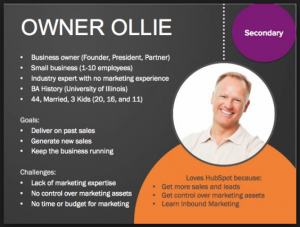How to Make a Strong Marketing Plan for 2016
I’m here to say, it’s 2016 and marketing has changed. A lot. Marketing is no longer centered around your product, but your customer.
Now’s a good time to update your marketing plan (you have a marketing plan, right?). Make it your road map for this year’s marketing initiatives. Use it to set goals that you can check on from time to time—and say, “Oh, yeah, lookin’ good” or “Oh, sh*t, we’re totally off.” If you Google “marketing plan template,” you’ll find a standard outline consisting of about ten things you could include—like a SWOT analysis, USP and pricing strategies.
There are some things in your old plan that you should keep, like your good ol’ Executive Summary. Because, let’s be honest—not everyone in the organization is going to nerd out over a marketing plan. Give them a one-page glimpse into the following 30 or so pages and tell them your main objectives and maybe what you’ll be nagging them for (blogs, case studies, customer testimonials…there will be plenty). Also list your biggest competitors and know what they are doing. But don’t concentrate on them. They might cause you to lose focus on your targets.
Before we jump into the outline I’m going to get on my soapbox and remind you about something so vitally important to your marketing plan that if you don’t plan to embrace this, you might fall behind in 2016.
Your plan should be highly targeted.
I can’t stress how important it is to do research and figure out just who you are targeting. Buyer personas are the cornerstone for a successful marketing plan. If you can’t tell me exactly who you’re trying to reach, you’ll fall behind your competitors who can. It’s easier now to laser-target a soccer mom in her early 40s who lives in the Midwest and loves taking Zumba classes than it was 10 years ago. So don’t miss out. See how to create a buyer persona with this free template from Hubspot.
Three important things to know—things I’ve found most helpful to pay attention to: Know your target’s challenges, know why they need your services or products, and know what message you’re trying to get across to them. This info can drive all of the following tactics. It’ll also help you distinguish between each segment you’re trying to reach. Because a message to that Zumba-loving soccer mom will be different than one to a recent college grad.
After we did research on our targets here at AB&C, we created mini-marketing plans to target each one within our larger marketing plan. We were able to set up goals to track and flesh out separate tactics for each group. For instance, we speak at conferences each year for one group—and that always leads to at least one larger new client. For other targets, we’re still building brand awareness, so digital media and inbound are going to be a major focus. But we know we need to speak to each buyer differently. Because a healthcare marketer doesn’t have the same challenges as a b2b CMO. This is a strategy I highly recommend you look into developing.
To make sure you’re not living in 1994, here’s how to outline your 2016 marketing plan:
Executive summary
Like I said, you might be the only one who will nerd out over ROI and ads. Sum it up so everyone else understands what you’re trying to accomplish this year.
Brand awareness strategy
Every organization wants to increase brand awareness. This is not a target-specific goal. Maybe you want to be known as a local organization. List your goals—enhance thought leadership, bring in more local leads—and the message you want people to know—“I’m New York’s most pleasant dentist.” Then list the tactics you’ll use to reach those goals. This is a great way to show off your organization’s people, personality and culture. People like to connect with people. Tactics can include digital media, blogs, social media and local sponsorships. This is also a good place to mention your competitors and anything else that might be important to your brand.
Target market # 1
(and then repeat this for every target market you have)

There are plenty of templates and examples of buyer personas out there. But your going to have to do the research to create ones unique to your organization.
Buyer persona. Begin by listing their demographics, challenges, why they need or use your services or products, and the marketing message you’re trying to convey to them. This is a great place to have these helpful bits of information available so you can check and make sure each tactic is homing in on each target’s specific message.
Campaigns. Spell out the details if you know you’ll be launching a specific campaign for a particular buyer persona—when you plan to launch it and what marketing pieces you’ll be using. You might include the tactics below or you might craft a specific strategy on top of your yearlong strategy to target this specific group.
Tactics. For each of the following, include a write-up with goals, admins and timetables for each tactic. Depending on your target audience, you might use all of these, a combo of a few or none.
- Inbound marketing. Create content—ebooks, case studies, whitepapers—and make it available for download on your website. This content should answer the most common questions your customers have. Content will help convert web traffic into leads. A million website visitors don’t mean a thing if you don’t have a way to follow up with them! Get them to convert and filter them into an inbound system that sends them automated emails to help move them to a sales qualified lead.
- A strong blog strategy is a great way to boost SEO and help set your organization up as a thought leader. Not blogging yet? Here is a guide to get you started.
- Digital media. Banner ads are great and so are text ads. They can revolve around your brand, company name or general industry terms. You’ll either have to do some research to make sure you choose the best combo of words – what will this target use to search for you or services you provide?
- Social media. Social media isn’t for everyone or everything. But Facebook advertising and other social media methods can certainly work. Just be sure to keep a close eye on them. Don’t just have accounts to “have accounts”.
- Nothing beats a strong relationship. Make those calls and follow up with current clients to keep them delighted and referring.
- Conferences are still highly effective ways to meet new people and find new clients.
- Public relations. Are there certain industry pubs you’d like to contribute to? Do you have a new product launch coming up? Plan how to best get attention for it.
- Print isn’t dead. It’s harder to calculate the ROI for it than for, say, inbound or digital media, but print can still play an important part in brand awareness. List out brochures, direct mailers or anything else you plan on doing.
- Will you have a specific page or area on your website for this target? How will you make sure your website works harder for you in 2016?
Marketing team
Outline your expectations for 2016 and who’s responsible for what. If you’re the lone marketing ranger, maybe form a marketing team with sales and operations people. You’d be surprised how helpful they can be.
Create an appendix that includes your blog plan, media plans and calendar of events.
So put the SWOT analysis aside and focus on your buyers. Make your 2016 marketing plan about them—and they’ll reward you for it.





